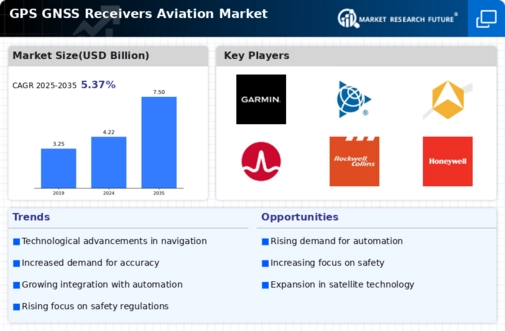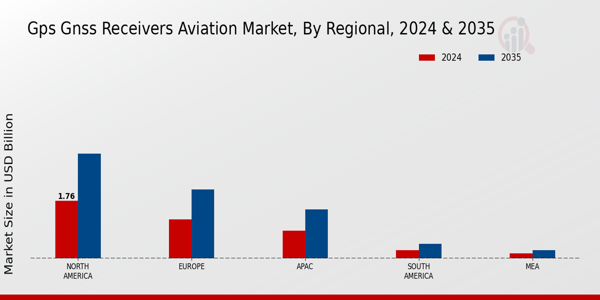Commercial Aviation
General Aviation
Military Aviation
Drones
Helicopters
Standalone Receivers
Integrated Receivers
Board Level Receivers
Global Positioning System
Global Navigation Satellite System
Differential GPS
Augmented GPS
Pilot Training
Flight Operations
Surveillance and Monitoring
North America
Europe
South America
Asia Pacific
Middle East and Africa
North America Outlook (USD Billion, 2019-2035)
North America GPS GNSS Receivers Aviation Market by Application Type
Commercial Aviation
General Aviation
Military Aviation
Drones
Helicopters
North America GPS GNSS Receivers Aviation Market by Receiver Type
Standalone Receivers
Integrated Receivers
Board Level Receivers
North America GPS GNSS Receivers Aviation Market by Technology Type
Global Positioning System
Global Navigation Satellite System
Differential GPS
Augmented GPS
North America GPS GNSS Receivers Aviation Market by End Use Type
Pilot Training
Flight Operations
Surveillance and Monitoring
North America GPS GNSS Receivers Aviation Market by Regional Type
US
Canada
US Outlook (USD Billion, 2019-2035)
US GPS GNSS Receivers Aviation Market by Application Type
Commercial Aviation
General Aviation
Military Aviation
Drones
Helicopters
US GPS GNSS Receivers Aviation Market by Receiver Type
Standalone Receivers
Integrated Receivers
Board Level Receivers
US GPS GNSS Receivers Aviation Market by Technology Type
Global Positioning System
Global Navigation Satellite System
Differential GPS
Augmented GPS
US GPS GNSS Receivers Aviation Market by End Use Type
Pilot Training
Flight Operations
Surveillance and Monitoring
CANADA Outlook (USD Billion, 2019-2035)
CANADA GPS GNSS Receivers Aviation Market by Application Type
Commercial Aviation
General Aviation
Military Aviation
Drones
Helicopters
CANADA GPS GNSS Receivers Aviation Market by Receiver Type
Standalone Receivers
Integrated Receivers
Board Level Receivers
CANADA GPS GNSS Receivers Aviation Market by Technology Type
Global Positioning System
Global Navigation Satellite System
Differential GPS
Augmented GPS
CANADA GPS GNSS Receivers Aviation Market by End Use Type
Pilot Training
Flight Operations
Surveillance and Monitoring
Europe Outlook (USD Billion, 2019-2035)
Europe GPS GNSS Receivers Aviation Market by Application Type
Commercial Aviation
General Aviation
Military Aviation
Drones
Helicopters
Europe GPS GNSS Receivers Aviation Market by Receiver Type
Standalone Receivers
Integrated Receivers
Board Level Receivers
Europe GPS GNSS Receivers Aviation Market by Technology Type
Global Positioning System
Global Navigation Satellite System
Differential GPS
Augmented GPS
Europe GPS GNSS Receivers Aviation Market by End Use Type
Pilot Training
Flight Operations
Surveillance and Monitoring
Europe GPS GNSS Receivers Aviation Market by Regional Type
Germany
UK
France
Russia
Italy
Spain
Rest of Europe
GERMANY Outlook (USD Billion, 2019-2035)
GERMANY GPS GNSS Receivers Aviation Market by Application Type
Commercial Aviation
General Aviation
Military Aviation
Drones
Helicopters
GERMANY GPS GNSS Receivers Aviation Market by Receiver Type
Standalone Receivers
Integrated Receivers
Board Level Receivers
GERMANY GPS GNSS Receivers Aviation Market by Technology Type
Global Positioning System
Global Navigation Satellite System
Differential GPS
Augmented GPS
GERMANY GPS GNSS Receivers Aviation Market by End Use Type
Pilot Training
Flight Operations
Surveillance and Monitoring
UK Outlook (USD Billion, 2019-2035)
UK GPS GNSS Receivers Aviation Market by Application Type
Commercial Aviation
General Aviation
Military Aviation
Drones
Helicopters
UK GPS GNSS Receivers Aviation Market by Receiver Type
Standalone Receivers
Integrated Receivers
Board Level Receivers
UK GPS GNSS Receivers Aviation Market by Technology Type
Global Positioning System
Global Navigation Satellite System
Differential GPS
Augmented GPS
UK GPS GNSS Receivers Aviation Market by End Use Type
Pilot Training
Flight Operations
Surveillance and Monitoring
FRANCE Outlook (USD Billion, 2019-2035)
FRANCE GPS GNSS Receivers Aviation Market by Application Type
Commercial Aviation
General Aviation
Military Aviation
Drones
Helicopters
FRANCE GPS GNSS Receivers Aviation Market by Receiver Type
Standalone Receivers
Integrated Receivers
Board Level Receivers
FRANCE GPS GNSS Receivers Aviation Market by Technology Type
Global Positioning System
Global Navigation Satellite System
Differential GPS
Augmented GPS
FRANCE GPS GNSS Receivers Aviation Market by End Use Type
Pilot Training
Flight Operations
Surveillance and Monitoring
RUSSIA Outlook (USD Billion, 2019-2035)
RUSSIA GPS GNSS Receivers Aviation Market by Application Type
Commercial Aviation
General Aviation
Military Aviation
Drones
Helicopters
RUSSIA GPS GNSS Receivers Aviation Market by Receiver Type
Standalone Receivers
Integrated Receivers
Board Level Receivers
RUSSIA GPS GNSS Receivers Aviation Market by Technology Type
Global Positioning System
Global Navigation Satellite System
Differential GPS
Augmented GPS
RUSSIA GPS GNSS Receivers Aviation Market by End Use Type
Pilot Training
Flight Operations
Surveillance and Monitoring
ITALY Outlook (USD Billion, 2019-2035)
ITALY GPS GNSS Receivers Aviation Market by Application Type
Commercial Aviation
General Aviation
Military Aviation
Drones
Helicopters
ITALY GPS GNSS Receivers Aviation Market by Receiver Type
Standalone Receivers
Integrated Receivers
Board Level Receivers
ITALY GPS GNSS Receivers Aviation Market by Technology Type
Global Positioning System
Global Navigation Satellite System
Differential GPS
Augmented GPS
ITALY GPS GNSS Receivers Aviation Market by End Use Type
Pilot Training
Flight Operations
Surveillance and Monitoring
SPAIN Outlook (USD Billion, 2019-2035)
SPAIN GPS GNSS Receivers Aviation Market by Application Type
Commercial Aviation
General Aviation
Military Aviation
Drones
Helicopters
SPAIN GPS GNSS Receivers Aviation Market by Receiver Type
Standalone Receivers
Integrated Receivers
Board Level Receivers
SPAIN GPS GNSS Receivers Aviation Market by Technology Type
Global Positioning System
Global Navigation Satellite System
Differential GPS
Augmented GPS
SPAIN GPS GNSS Receivers Aviation Market by End Use Type
Pilot Training
Flight Operations
Surveillance and Monitoring
REST OF EUROPE Outlook (USD Billion, 2019-2035)
REST OF EUROPE GPS GNSS Receivers Aviation Market by Application Type
Commercial Aviation
General Aviation
Military Aviation
Drones
Helicopters
REST OF EUROPE GPS GNSS Receivers Aviation Market by Receiver Type
Standalone Receivers
Integrated Receivers
Board Level Receivers
REST OF EUROPE GPS GNSS Receivers Aviation Market by Technology Type
Global Positioning System
Global Navigation Satellite System
Differential GPS
Augmented GPS
REST OF EUROPE GPS GNSS Receivers Aviation Market by End Use Type
Pilot Training
Flight Operations
Surveillance and Monitoring
APAC Outlook (USD Billion, 2019-2035)
APAC GPS GNSS Receivers Aviation Market by Application Type
Commercial Aviation
General Aviation
Military Aviation
Drones
Helicopters
APAC GPS GNSS Receivers Aviation Market by Receiver Type
Standalone Receivers
Integrated Receivers
Board Level Receivers
APAC GPS GNSS Receivers Aviation Market by Technology Type
Global Positioning System
Global Navigation Satellite System
Differential GPS
Augmented GPS
APAC GPS GNSS Receivers Aviation Market by End Use Type
Pilot Training
Flight Operations
Surveillance and Monitoring
APAC GPS GNSS Receivers Aviation Market by Regional Type
China
India
Japan
South Korea
Malaysia
Thailand
Indonesia
Rest of APAC
CHINA Outlook (USD Billion, 2019-2035)
CHINA GPS GNSS Receivers Aviation Market by Application Type
Commercial Aviation
General Aviation
Military Aviation
Drones
Helicopters
CHINA GPS GNSS Receivers Aviation Market by Receiver Type
Standalone Receivers
Integrated Receivers
Board Level Receivers
CHINA GPS GNSS Receivers Aviation Market by Technology Type
Global Positioning System
Global Navigation Satellite System
Differential GPS
Augmented GPS
CHINA GPS GNSS Receivers Aviation Market by End Use Type
Pilot Training
Flight Operations
Surveillance and Monitoring
INDIA Outlook (USD Billion, 2019-2035)
INDIA GPS GNSS Receivers Aviation Market by Application Type
Commercial Aviation
General Aviation
Military Aviation
Drones
Helicopters
INDIA GPS GNSS Receivers Aviation Market by Receiver Type
Standalone Receivers
Integrated Receivers
Board Level Receivers
INDIA GPS GNSS Receivers Aviation Market by Technology Type
Global Positioning System
Global Navigation Satellite System
Differential GPS
Augmented GPS
INDIA GPS GNSS Receivers Aviation Market by End Use Type
Pilot Training
Flight Operations
Surveillance and Monitoring
JAPAN Outlook (USD Billion, 2019-2035)
JAPAN GPS GNSS Receivers Aviation Market by Application Type
Commercial Aviation
General Aviation
Military Aviation
Drones
Helicopters
JAPAN GPS GNSS Receivers Aviation Market by Receiver Type
Standalone Receivers
Integrated Receivers
Board Level Receivers
JAPAN GPS GNSS Receivers Aviation Market by Technology Type
Global Positioning System
Global Navigation Satellite System
Differential GPS
Augmented GPS
JAPAN GPS GNSS Receivers Aviation Market by End Use Type
Pilot Training
Flight Operations
Surveillance and Monitoring
SOUTH KOREA Outlook (USD Billion, 2019-2035)
SOUTH KOREA GPS GNSS Receivers Aviation Market by Application Type
Commercial Aviation
General Aviation
Military Aviation
Drones
Helicopters
SOUTH KOREA GPS GNSS Receivers Aviation Market by Receiver Type
Standalone Receivers
Integrated Receivers
Board Level Receivers
SOUTH KOREA GPS GNSS Receivers Aviation Market by Technology Type
Global Positioning System
Global Navigation Satellite System
Differential GPS
Augmented GPS
SOUTH KOREA GPS GNSS Receivers Aviation Market by End Use Type
Pilot Training
Flight Operations
Surveillance and Monitoring
MALAYSIA Outlook (USD Billion, 2019-2035)
MALAYSIA GPS GNSS Receivers Aviation Market by Application Type
Commercial Aviation
General Aviation
Military Aviation
Drones
Helicopters
MALAYSIA GPS GNSS Receivers Aviation Market by Receiver Type
Standalone Receivers
Integrated Receivers
Board Level Receivers
MALAYSIA GPS GNSS Receivers Aviation Market by Technology Type
Global Positioning System
Global Navigation Satellite System
Differential GPS
Augmented GPS
MALAYSIA GPS GNSS Receivers Aviation Market by End Use Type
Pilot Training
Flight Operations
Surveillance and Monitoring
THAILAND Outlook (USD Billion, 2019-2035)
THAILAND GPS GNSS Receivers Aviation Market by Application Type
Commercial Aviation
General Aviation
Military Aviation
Drones
Helicopters
THAILAND GPS GNSS Receivers Aviation Market by Receiver Type
Standalone Receivers
Integrated Receivers
Board Level Receivers
THAILAND GPS GNSS Receivers Aviation Market by Technology Type
Global Positioning System
Global Navigation Satellite System
Differential GPS
Augmented GPS
THAILAND GPS GNSS Receivers Aviation Market by End Use Type
Pilot Training
Flight Operations
Surveillance and Monitoring
INDONESIA Outlook (USD Billion, 2019-2035)
INDONESIA GPS GNSS Receivers Aviation Market by Application Type
Commercial Aviation
General Aviation
Military Aviation
Drones
Helicopters
INDONESIA GPS GNSS Receivers Aviation Market by Receiver Type
Standalone Receivers
Integrated Receivers
Board Level Receivers
INDONESIA GPS GNSS Receivers Aviation Market by Technology Type
Global Positioning System
Global Navigation Satellite System
Differential GPS
Augmented GPS
INDONESIA GPS GNSS Receivers Aviation Market by End Use Type
Pilot Training
Flight Operations
Surveillance and Monitoring
REST OF APAC Outlook (USD Billion, 2019-2035)
REST OF APAC GPS GNSS Receivers Aviation Market by Application Type
Commercial Aviation
General Aviation
Military Aviation
Drones
Helicopters
REST OF APAC GPS GNSS Receivers Aviation Market by Receiver Type
Standalone Receivers
Integrated Receivers
Board Level Receivers
REST OF APAC GPS GNSS Receivers Aviation Market by Technology Type
Global Positioning System
Global Navigation Satellite System
Differential GPS
Augmented GPS
REST OF APAC GPS GNSS Receivers Aviation Market by End Use Type
Pilot Training
Flight Operations
Surveillance and Monitoring
South America Outlook (USD Billion, 2019-2035)
South America GPS GNSS Receivers Aviation Market by Application Type
Commercial Aviation
General Aviation
Military Aviation
Drones
Helicopters
South America GPS GNSS Receivers Aviation Market by Receiver Type
Standalone Receivers
Integrated Receivers
Board Level Receivers
South America GPS GNSS Receivers Aviation Market by Technology Type
Global Positioning System
Global Navigation Satellite System
Differential GPS
Augmented GPS
South America GPS GNSS Receivers Aviation Market by End Use Type
Pilot Training
Flight Operations
Surveillance and Monitoring
South America GPS GNSS Receivers Aviation Market by Regional Type
Brazil
Mexico
Argentina
Rest of South America
BRAZIL Outlook (USD Billion, 2019-2035)
BRAZIL GPS GNSS Receivers Aviation Market by Application Type
Commercial Aviation
General Aviation
Military Aviation
Drones
Helicopters
BRAZIL GPS GNSS Receivers Aviation Market by Receiver Type
Standalone Receivers
Integrated Receivers
Board Level Receivers
BRAZIL GPS GNSS Receivers Aviation Market by Technology Type
Global Positioning System
Global Navigation Satellite System
Differential GPS
Augmented GPS
BRAZIL GPS GNSS Receivers Aviation Market by End Use Type
Pilot Training
Flight Operations
Surveillance and Monitoring
MEXICO Outlook (USD Billion, 2019-2035)
MEXICO GPS GNSS Receivers Aviation Market by Application Type
Commercial Aviation
General Aviation
Military Aviation
Drones
Helicopters
MEXICO GPS GNSS Receivers Aviation Market by Receiver Type
Standalone Receivers
Integrated Receivers
Board Level Receivers
MEXICO GPS GNSS Receivers Aviation Market by Technology Type
Global Positioning System
Global Navigation Satellite System
Differential GPS
Augmented GPS
MEXICO GPS GNSS Receivers Aviation Market by End Use Type
Pilot Training
Flight Operations
Surveillance and Monitoring
ARGENTINA Outlook (USD Billion, 2019-2035)
ARGENTINA GPS GNSS Receivers Aviation Market by Application Type
Commercial Aviation
General Aviation
Military Aviation
Drones
Helicopters
ARGENTINA GPS GNSS Receivers Aviation Market by Receiver Type
Standalone Receivers
Integrated Receivers
Board Level Receivers
ARGENTINA GPS GNSS Receivers Aviation Market by Technology Type
Global Positioning System
Global Navigation Satellite System
Differential GPS
Augmented GPS
ARGENTINA GPS GNSS Receivers Aviation Market by End Use Type
Pilot Training
Flight Operations
Surveillance and Monitoring
REST OF SOUTH AMERICA Outlook (USD Billion, 2019-2035)
REST OF SOUTH AMERICA GPS GNSS Receivers Aviation Market by Application Type
Commercial Aviation
General Aviation
Military Aviation
Drones
Helicopters
REST OF SOUTH AMERICA GPS GNSS Receivers Aviation Market by Receiver Type
Standalone Receivers
Integrated Receivers
Board Level Receivers
REST OF SOUTH AMERICA GPS GNSS Receivers Aviation Market by Technology Type
Global Positioning System
Global Navigation Satellite System
Differential GPS
Augmented GPS
REST OF SOUTH AMERICA GPS GNSS Receivers Aviation Market by End Use Type
Pilot Training
Flight Operations
Surveillance and Monitoring
MEA Outlook (USD Billion, 2019-2035)
MEA GPS GNSS Receivers Aviation Market by Application Type
Commercial Aviation
General Aviation
Military Aviation
Drones
Helicopters
MEA GPS GNSS Receivers Aviation Market by Receiver Type
Standalone Receivers
Integrated Receivers
Board Level Receivers
MEA GPS GNSS Receivers Aviation Market by Technology Type
Global Positioning System
Global Navigation Satellite System
Differential GPS
Augmented GPS
MEA GPS GNSS Receivers Aviation Market by End Use Type
Pilot Training
Flight Operations
Surveillance and Monitoring
MEA GPS GNSS Receivers Aviation Market by Regional Type
GCC Countries
South Africa
Rest of MEA
GCC COUNTRIES Outlook (USD Billion, 2019-2035)
GCC COUNTRIES GPS GNSS Receivers Aviation Market by Application Type
Commercial Aviation
General Aviation
Military Aviation
Drones
Helicopters
GCC COUNTRIES GPS GNSS Receivers Aviation Market by Receiver Type
Standalone Receivers
Integrated Receivers
Board Level Receivers
GCC COUNTRIES GPS GNSS Receivers Aviation Market by Technology Type
Global Positioning System
Global Navigation Satellite System
Differential GPS
Augmented GPS
GCC COUNTRIES GPS GNSS Receivers Aviation Market by End Use Type
Pilot Training
Flight Operations
Surveillance and Monitoring
SOUTH AFRICA Outlook (USD Billion, 2019-2035)
SOUTH AFRICA GPS GNSS Receivers Aviation Market by Application Type
Commercial Aviation
General Aviation
Military Aviation
Drones
Helicopters
SOUTH AFRICA GPS GNSS Receivers Aviation Market by Receiver Type
Standalone Receivers
Integrated Receivers
Board Level Receivers
SOUTH AFRICA GPS GNSS Receivers Aviation Market by Technology Type
Global Positioning System
Global Navigation Satellite System
Differential GPS
Augmented GPS
SOUTH AFRICA GPS GNSS Receivers Aviation Market by End Use Type
Pilot Training
Flight Operations
Surveillance and Monitoring
REST OF MEA Outlook (USD Billion, 2019-2035)
REST OF MEA GPS GNSS Receivers Aviation Market by Application Type
Commercial Aviation
General Aviation
Military Aviation
Drones
Helicopters
REST OF MEA GPS GNSS Receivers Aviation Market by Receiver Type
Standalone Receivers
Integrated Receivers
Board Level Receivers
REST OF MEA GPS GNSS Receivers Aviation Market by Technology Type
Global Positioning System
Global Navigation Satellite System
Differential GPS
Augmented GPS
REST OF MEA GPS GNSS Receivers Aviation Market by End Use Type
Pilot Training
Flight Operations
Surveillance and Monitoring












